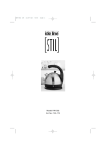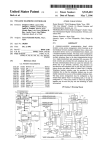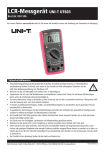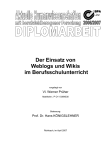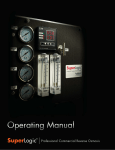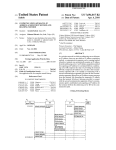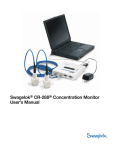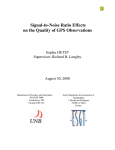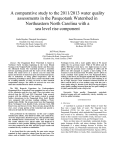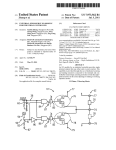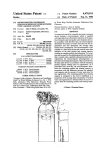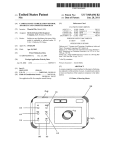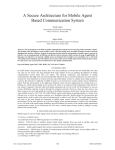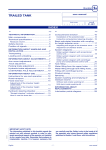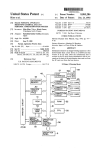Download Methods and apparatuses for measuring properties of a substance
Transcript
US008528399B2 (12) United States Patent (10) Patent N0.: (45) Date of Patent: Rainer et al. (54) METHODS AND APPARATUSES FOR MEASURING PROPERTIES OF A SUBSTANCE IN A PROCESS STREAM 5,988,203 6,000,290 6,000,427 6,067,151 6,170,515 (75) Inventors: Michael D. Rainer, Burton, OH (US); Peter J. Gillespie, Chagrin Falls, OH (US); Douglas J. Paige, Lakewood, OH (US); Kenneth J. Maynard, Amherst, OH (US) (73) Assignee: The Mercury Iron and Steel Co., Cleveland, OH (US) Notice: A A A A B1 3/2001 Klampfer 6,374,859 6,675,658 6,760,098 6,886,606 6,892,762 7,172,572 D562,169 7,343,933 D587,611 4/2002 1/2004 7/2004 5/2005 5/2005 2/2007 2/2008 3/2008 3/2009 B1 B2 B2 B2 B2 B2 S B2 S DE 19855218 A1 8/1999 OTHER PUBLICATIONS Prior Publication Data US 2012/0118058 A1 Vu et al. Petrich et al. Salo Few et al. Porter et al. Diamond et al. Oshima et al. McBeth et al. Oshima et al. FOREIGN PATENT DOCUMENTS May 13, 2011 (65) Hutton Benton et a1. Hutton Salo Peterson et a1. (Continued) U.S.C. 154(b) by 352 days. (22) Filed: Sep. 10, 2013 6,196,256 B1 Subject to any disclaimer, the term of this patent is extended or adjusted under 35 (21) App1.No.: 13/107,675 11/1999 12/1999 12/1999 5/2000 1/2001 US 8,528,399 B2 Pending Design U.S. Appl. No. 29/408,355, Sensing Apparatus, Michael D. Rainer et al., ?led Dec. 12, 2011. May 17, 2012 (Continued) Related U.S. Application Data (60) Provisional application No. 61/347,098, ?led on May 21, 2010. (51) (74) Attorney, Agent, or Firm * Ulmer & Berne LLP Int. Cl. G01F 1/68 G01N 21/41 (52) (2006.01) (2006.01) U.S. Cl. USPC (58) ...................................... .. 73/204.11; 356/135 (57) ABSTRACT References Cited A ?ow-through sensing apparatus includes a ?ow-head and a sensor that are con?gured to be selectively coupled through use of a quick-disconnect mechanical coupling. When the sensor is coupled With the ?ow-head, the sensor cooperates With the ?ow-head to at least partially de?ne a sensing cham U.S. PATENT DOCUMENTS eter, such as refractive index, regarding a substance in the Field of Classi?cation Search USPC ............. .. 73/204.11; 356/128*137, 3354343 See application ?le for complete search history. (56) 4,182,362 4,726,399 5,342,126 5,583,300 Primary Examiner * Harshad R Patel Assistant Examiner * Brandi N Hopkins A A A A 1/1980 2/1988 8/1994 12/1996 Hewson et a1. Miller Heston et a1. Green et a1. ber. The sensor is con?gured to determine a process param sensing chamber. 24 Claims, 9 Drawing Sheets US 8,528,399 B2 Page 2 (56) References Cited U.S. PATENT DOCUMENTS 7,509,855 B2 D602,794 S D609,591 S 3/2009 Garvin 10/2009 Oshima 2/2010 Oshima et al. Jetalon Solutions, Inc., document entitled, “Concentration Monitor NX-148 Hammerhead”, Jun. 2010, 2 pages. Depicted components believed to be in public use prior to May 21, 2009. Swagelok Company, manual entitled, “Swagelok CR-288 Concen tration Monitor User’s Manual”, Jun. 2006, 32 pages. Depicted com ponents believed to be in public use prior to May 21, 2009. OTHER PUBLICATIONS K-Patents, Inc., manual entitled, “Semicon Process Refractometer PR-33-S”, Mar. 2010, 38 pages. Depicted components believed to be in public use prior to May 21, 2009. K-Patents, Inc., document entitled, “Concentration Monitoring of Fab Chemicals In Cleanroom Environments”, Jan. 2009, 6 pages. Depicted components believed to be in public use prior to May 21, Bronkhorst High-Tech, document entitled, “FloW-SMS: Mass Flow Surface Mount Solutions”, Apr. 2006, 1 page. Depicted components believed to be in public use prior to May 21, 2009. Bronkhorst High-Tech, document entitled, “Mani-Flow: Customised Manifold Solutions for Mass Flow and Pressure”, Jul. 2006, 1 page. Depicted components believed to be in public use prior to May 21, K-Patents, Inc., document entitled, “PR-33-S Sensor Installation”, 2 pages. Depicted components believed to be in public use prior to May 21, 2009. Mettler Toledo, manual entitled, “InFloW 751 Instruction Manual”, Sep. 1997, 7 pages. Depicted components believed to be in public use prior to May 21, 2009. 2008/0006085 2008/0135116 2009/0025472 2010/0064799 A1 A1 A1 A1 1/2008 Yamashita et al. 6/2008 Sugiura et al. 1/2009 Garvin 3/2010 Mais et al. 2009. 2009. Omega Engineering, Inc., document entitled, “Industrial pH Instru Burkert Fluid Control Systems, document entitled, “INLINE ?tting mentation & Electrodes Flat Surface pH/ORP Industrial Electrodes”, Mar. 2009, 3 pages. Depicted components believed to be in public use With paddle-Wheel for ?ow measuremen ”, Jul. 5, 2010, 10 pages. Depicted components believed to be in public use prior to May 21, 2009. prior to May 21, 2009. Omega Engineering, Inc., document entitled, “Industrial pH Instru Burkert Fluid Control Systems, document entitled, “Positive dis placement ?ow ?tting for continuous measurement and batch con mentation & Electrodes In Line Flat Surface pH/ORP Electrodes”, Mar. 2009, 2 pages. Depicted components believed to be in public use trol”, Sep. 21, 2010, 4 pages. Depicted components believed to be in public use prior to May 21, 2009. Innovative Waters, LLC, document entitled, “Manifolds”, WWW.in novativewaters.com/manifold.html, 2009, retrieved Oct. 19, 2010, 2 pages. Depicted components believed to be in public use prior to May 21, 2009. prior to May 21, 2009. HM Digital, Inc., document entitled, “SM-1: In-Line Single TDS Monitor”, WWW.tdsmeter.com/products/sm1.html, retrieved Oct. 19, 2010, 1 page. Depicted components believed to be in public use prior to May 21,2009. Omega Engineering, Inc., document entitled, “Industrial pH Instru mentation & Electronics Retractable Lock-N-Load ALpHA pH/ORP Electrode Assemblies”, Sep. 2009, 3 pages. Depicted components believed to be in public use prior to May 21, 2009. “The PR-1000 Inline Process Refractometer”, AFAB Enterprises, May 5, 2009, 25 pages. Depicted components believed to be in public use prior to May 21, 2009. Pending Design U.S. Appl. No. 29/365,064, Sensing Apparatus, Michael D. Rainer et al., ?led Jul. 2, 2010. US. Patent Sep. 10, 2013 Sheet 2 of9 US 8,528,399 B2 US. Patent Sep. 10, 2013 Sheet 3 of9 US 8,528,399 B2 US. Patent Sep. 10, 2013 Sheet 4 of9 US 8,528,399 B2 FIG.4 16 1O 52 50 46 42 54 1'104456 US. Patent 0: Sep. 10, 2013 Sheet 5 of9 US 8,528,399 B2 US. Patent Sep. 10, 2013 GIm Sheet 6 of9 US 8,528,399 B2 US. Patent Sep. 10, 2013 Sheet 7 of9 US 8,528,399 B2 US. Patent Se .10 2013 Sheet8 0f9 US. Patent Sep. 10, 2013 Sheet 9 of9 US 8,528,399 B2 FIG. 9C ‘k V & 5% US 8,528,399 B2 1 2 METHODS AND APPARATUSES FOR MEASURING PROPERTIES OF A SUBSTANCE IN A PROCESS STREAM BRIEF DESCRIPTION OF THE DRAWINGS It is believed that certain embodiments Will be better under stood from the folloWing description taken in conjunction With the accompanying draWings in Which: REFERENCE TO RELATED APPLICATION FIG. 1 is a front perspective vieW depicting a ?oW-through sensing apparatus in accordance With one embodiment, Wherein the ?oW-through sensing apparatus is in association The present application claims priority of US. provisional application Ser. No. 61/347,098 ?led May 21, 2010, and hereby incorporates the same provisional application herein by reference in its entirety. With a portion of a supply conduit and a portion of a discharge TECHNICAL FIELD ?oW-through sensing apparatus of FIG. 1, and apart from the remaining components of FIG. 1; conduit; FIG. 2A is a front perspective depicting a ?oW-head of the FIG. 2B is a rear perspective vieW depicting the ?oW-head A ?oW-through sensing apparatus is provided and is con of FIG. 2A; FIG. 2C is a cross-sectional vieW generally depicting the ?oW-head of FIG. 2A; ?gured for sensing one or more physical properties or process parameters regarding a substance of interest. FIG. 3A is a front perspective depicting a sensor of the BACKGROUND Conventional in-line sensors monitor physical properties 20 FIG. 3B is a rear perspective vieW depicting the sensor of or process parameters regarding ?uid ?oWing through pipes FIG. 3A; or other conduits. In many instances, installation, calibration or replacement of conventional in-line sensors requires tem porarily stopping the ?oW of ?uid through the conduits, or disconnecting the conduits. FIG. 4 is a cross-sectional vieW depicting the components of FIG. 1; 25 head de?nes an input port and an output port and comprises a ?rst mating feature. The sensor comprises a sensing element and a second mating feature. The ?rst mating feature is con ?gured to selectively engage the second mating feature in a tWist-lock con?guration to provide a quick-disconnect mechanical coupling betWeen the sensor and the ?oW-head. When the sensor is coupled With the ?oW-head, the sensor cooperates With the ?oW-head to at least partially de?ne a sensing chamber. The sensing chamber is in ?uid communi cation With each of the input port, the output port, and the embodiment; 30 input port, the output port, and the sensing element. FIG. 5B is another schematic vieW illustrating operation of the optical sensor of FIG. 5A; FIG. 6 is a perspective vieW depicting a ?oW-through sens ing apparatus in accordance With another embodiment, Wherein the ?oW-through sensing apparatus is in association With multiple supply conduits and at least one discharge conduit; 35 FIG. 7 is a perspective vieW depicting a ?oW-through sens ing apparatus in accordance With yet another embodiment, Wherein the ?oW-through sensing apparatus is in association With a portion of a supply conduit and a portion of a discharge conduit; 40 FIG. 8 is a perspective vieW depicting a ?oW-through sens ing apparatus in accordance With another embodiment; FIG. 9A is a front perspective vieW depicting a ?oW sensing element. The sensing element is con?gured to deter mine the refractive index of a substance in the sensing cham ber. In accordance With another embodiment, a ?oW-through sensing apparatus comprises a ?oW-head and a sensor. The ?oW-head de?nes an input port and an output port. The sensor comprises a sensing element. The ?oW-head and the sensor cooperate to de?ne means for quick-disconnect mechanically coupling the sensor and the ?oW-head. When the sensor is coupled With the ?oW-head, the sensor cooperates With the ?oW-head to at least partially de?ne a sensing chamber. The sensing chamber is in ?uid communication With each of the FIG. 5A is a schematic vieW illustrating certain compo nents of the sensor of FIG. 3A in accordance With one SUMMARY In accordance With one embodiment, a ?oW-through sens ing apparatus comprises a ?oW-head and a sensor. The ?oW ?oW-through sensing apparatus of FIG. 1, and apart from the remaining components of FIG. 1; through sensing apparatus in accordance With yet another embodiment, Wherein the ?oW-through sensing apparatus is 45 in association With a portion of a supply conduit and a portion of a discharge conduit; 50 FIG. 9B is a rear perspective vieW depicting the compo nents of FIG. 9A; FIG. 9C is a cross-sectional vieW depicting the components of FIGS. 9A-9B; and FIG. 9D is a perspective vieW depicting the components of FIGS. 9A-9C, but Wherein the sensor is uncoupled from the ?oW-head. 55 DETAILED DESCRIPTION In accordance With yet another embodiment, a sensor is con?gured for quick-disconnect mechanical coupling With a FIG. 1 illustrates a ?oW-through sensing apparatus in its assembled state. According to this embodiment, the ?oW ?oW-head. The sensor comprises a sensing element and a through sensing apparatus comprises an integrated ?oW-head mating feature. The mating feature is con?gured to selec tively engage a ?oW-head in a tWist-lock con?guration to 60 provide a quick-disconnect mechanical coupling betWeen the sensor and a ?oW-head. When the sensor is coupled With a 10 having multiple ports 12, 13, 14, and 16, a sensor 24 that is removably connected to ?oW-head 10 by Way of a quick disconnect coupling 26, a retractable locking mechanism 28 ?oW-head, the sensor cooperates to at least partially de?ne a for locking sensor 24 to ?oW-head 10, a communication ele sensing chamber. The sensing chamber is in ?uid communi cation With the sensing element. The sensing element is con ?gured to determine the refractive index of substance in the ment 30 for receiving poWer and/or communicating With sensing chamber. 65 external devices, and a mounting bracket 32 Which can be used to mount the apparatus to another object. At least one of the ports 12, 13, 14, and 16 can be con?gured as an input port, US 8,528,399 B2 3 4 While at least one other one ofthe ports 12, 13, 14, and 16 can be con?gured as an output port. In one embodiment, at least FIG. 2B, the ?oW-head 10 can de?ne an annular channel 43, and the chamber seal 42 can comprise an 0-ring that can be at one of the ports 12, 13, 14, and 16 can comprise a respective threaded aperture in the ?oW-head 10. HoWever, it Will be appreciated that one or more of the ports 12, 13, 14, and 16 might not be threaded. For example, With reference to the ?oW-through sensing apparatus of FIGS. 9A-9D, a ?oW-head can include only tWo ports (i.e., a single input port and a single output port), and each of tho se ports can comprise a respective least partially received Within the annular channel 43. It Will be appreciated that a chamber seal can be provided in any of a variety of other suitable con?gurations. The quick-disconnect coupling 26 can facilitate selective attachment of sensor 24 to ?oW-head 10, and can facilitate simple and quick removal and replacement of sensor 24 rela tive to ?oW-head 10, such as for cleaning and maintenance of push-type compression ?tting such as for receiving plastic or metal tubing as generally shoWn. In still other embodiments, sensor 24. More particularly, the quick-disconnect coupling 26 can include one or more mating features on ?oW-head 10 Which can selectively engage one or more corresponding ports on a ?oW-head can comprise hose barb type ?ttings, tubing, or any of a variety of other suitable types of ?ttings or connections. The ?oW-through sensing apparatus can be positioned in a mating features on sensor 24, to join the tWo components into a single uni?ed ?uid-tight assembly. For example, as shoWn With reference to FIGS. 1, 2A-2B, 3A-3B, and 4, the ?oW head 10 can comprise a body 11 and mating features in the bypass stream that runs in parallel to a main process stream containing a substance of interest. A substance from the main process stream can be diverted to the ?oW-through sensing apparatus by a supply conduit 20 and likeWise, be carried aWay from the apparatus by a discharge conduit 22. form of ?anges 40a, 40b, 40c, and 40d extending from the body 11. The sensor 24 can comprise a body 25 and mating 20 Supply conduit 20 and discharge conduit 22 can each com prise any of a variety of suitable rigid or ?exible hose, tubing, piping or other plumbing conveyance for conveying or con ducting a test substance to and from the apparatus. Examples include readily available off-the-shelf tube ?ttings, hose cou ?oW-head 10 and the sensor 24 can selectively engage one 25 plings, pipe ?ttings, quick-disconnect ?ttings, instrumenta tion ?ttings, compression ?ttings, and the like. The substance of interest can be a ?uid Which includes, but is not limited to, any single one or combination of liquids, gasses, or solids, including homogenous or non-homoge 30 required to cause the substance to ?oW through the ?oW through sensing apparatus can be generated by any of a vari lock action, a partial-tum of the sensor 24 relative to the ety of sources including, for example, gravity feed, external ?oW-head 10 can result in movement of the sensor 24 relative 35 tion, or the like. Alternatively, this force can be generated from an internal pumping assembly located Within ?oW-head to the ?oW-head 10 betWeen an unlocked position and a fully locked position. FIGS. 1 and 4 illustrate the sensor 24 in the fully locked position relative to the ?oW-head 10. In the embodiment of FIGS. 1 and 4, an eighth-tum (i.e., 45 10. Although the ?oW-through sensing apparatus is described above as being positioned in a bypass stream, it should be understood that in the embodiments presented herein, noth another in a tWist-lock con?guration to provide a quick-dis connect mechanical coupling betWeen the sensor 24 and the ?oW-head 10. For example, to couple the sensor 24 With the ?oW-head 10 through the tWist-lock action, each of the ?anges 48a, 48b, 48c, and 48d can be received Within a respective one of the grooves 41a, 41b, 41c, and 41d and sandWiched or compressed betWeen a corresponding respec tive one ofthe ?anges 40a, 40b, 40c, and 40d and the body 11. Accordingly, in this con?guration, to facilitate the tWist neous mixtures, emulsions, or colloidal solutions. The force pumps, pressure or temperature differential, chemical reac features in the form of ?anges 48a, 48b, 48c, and 48d extend ing from the body 25. The ?anges 40a, 40b, 40c, and 40d can cooperate With the body 11 to de?ne respective grooves 41a, 41b, 41c, and 41d. The respective mating features of the 40 degrees) of the sensor 24 relative to the ?oW-head 10 can achieve movement of the sensor 24 relative to the ?oW-head 10 betWeen the unlocked position and the fully locked posi tion. HoWever, to facilitate the tWist-lock con?guration, it Will ing limits the ?oW-through sensing apparatus from being placed in the actual main process stream, should supply con duit 20 and discharge conduit 22 of that process stream be be appreciated that a different amount of rotation less than constructed in such a manner as to be compatible With the siZe 45 can alternatively achieve movement of a sensor relative to a 360 degrees (e.g., 90 degrees, 120 degrees, or 180 degrees) and ?oW-rate parameters of the ?oW-through sensing appa ?oW-head betWeen an unlocked position and a fully locked position. In still other embodiments, a different amount of rotation greater than or equal to 360 degrees can alternatively ratus. Referring noW to FIGS. 2-3, the integrated ?oW-head 10 is shoWn to be separated from sensor 24. In this embodiment, the ports 12 and 13 can be con?gured as input ports for connecting one or more supply conduits (e.g., 20) to selec tively convey a substance into ?oW-head 10, and the ports 14 and 16 canbe con?gured as output ports for connecting one or more discharge conduits (e. g., 22) to selectively convey a substance aWay from ?oW-head 10. With reference to FIG. 4, the ports 12 and 13 can each be in ?uid communication With an input channel 50 and an input channel opening 44, and ports 14 and 16 can each be in ?uid communication With an output channel 52 and an output channel opening 46. When ?oW-head 10, sensor 24, and a chamber seal 42 are mated in achieve movement of a sensor relative to a ?oW-head betWeen 50 and a sensor can be achieved through use of any of a variety 55 60 the fully assembled state as shoWn in FIG. 4, a sensing cham ber 54 can be created and provided in communication With both the input channel opening 44 and the output channel opening 46. The chamber seal 42 can be provided on either the sensor 24 or the ?oW-head 10 and can facilitate a seal 65 betWeen the sensor 24 and the ?oW-head 10 When the sensor 24 is coupled With the ?oW-head 10. For example, as shoWn in an unlocked position and a fully locked position. It Will be appreciated that selective mechanical coupling of a ?oW-head of other suitable mechanical features. When the sensor 24 is in the fully locked position relative to the ?oW-head 10, the retractable locking mechanism 28 can be selectively operated to prevent inadvertent rotation or unlocking of the sensor 24 relative to the ?oW-head 10. For example, as shoWn in FIG. 2C, the ?oW-head 10 can comprise the retractable locking mechanism 28, Which can include a thumb-lever 35 Which is attached to a pin 38. A portion of the pin 38 can be slideably received Within a bore 34 formed in the ?oW-head 10, and locking clips 37a and 37b can be provided to position and lock the thumb -lever 35 to the pin 38. An operator can operate the retractable locking mechanism 28 by sliding the thumb-lever 35 along a comer of the ?oW head 1 0. Once the pin 38 is in the retracted position, sensor 24 can be rotated (e.g., 45 degrees) to an unlocked position for US 8,528,399 B2 5 6 removal from the ?oW-head 10. A spring 36 can be located sensor can Wirelessly transmit a communications signal, and behind the pin 38 for biasing the thumb-lever 35 to keep the pin 38 engaged When manual pressure on the thumb-lever 35 is absent. It Will be appreciated that a retractable locking scavenge poWer Wirelessly and/ or from the substance ?oWing through the sensor, and therefore might not include an elec mechanism can be provided in any of a variety of other over ?eld Wiring to a signal converter, a visual display, data con?gurations. For example, in one alternative con?guration, logger, computer, PLC, chart recorder, relay, valve, pump, trical connector. The signal or data can be sent Wirelessly or as shoWn in FIG. 8, a thumb-lever 235 of a retractable locking sensor, Wireless access point, internet or other computer net mechanism can be con?gured for sliding along an edge face Work, industrial ?eld bus, or any other external device capable of receiving the signal or data. FloW-head 10, sensor 24, and component parts of each, can of a ?oW-head 210. In another alternative embodiment (not shoWn), a sensor, as opposed to a ?oW-head (e.g., 10), can comprise a retractable locking mechanism. In lieu of a retract be constructed from any material or combination of materials able pin, it Will be appreciated that any of a variety of other suitable mechanical devices can be provided to selectively that is/are chemically and physically compatible With the prevent inadvertent rotation or unlocking of the sensor 24 relative to the ?oW-head 10. It Will also be appreciated that a include a nearly limitless combination of metals, ceramics, plastics and other materials. LikeWise, it is contemplated that these components can be manufactured using any combina tion of manufacturing techniques including, but not limited substance to be tested and the testing environment. This can ?oW-through sensing apparatus might not include any retract able locking mechanism or other locking device such as, for example, With respect to the ?oW-through sensing apparatus to, machining, casting, injection molding, material deposi depicted in FIGS. 9A-9D. tion, forming, or Wire, laser, plasma, or Water cutting. One or The mounting bracket 32 can be attached to a face of ?oW-head 10 in order to ?x ?oW-head 10 to another object 20 such as a Wall, C-channel, or other structure. In the event that sensor 24 Were to be removed from ?oW-head 10, and How to include ?ns 99 . Additional or alternative cooling provisions head 10 Were connected to another object by Way of mounting bracket 32, then sensor 24 can be removed Without the need to both of the ?oW-head 10 and the sensor 24 can be provided With ?ns or heatsinks to facilitate self-cooling for prevention of overheating. For example, the sensor 24 is shoWn in FIG. 1 can be provided for one or both of a ?oW-head and a sensor of 25 a ?oW-through sensing apparatus including, for example, disassemble the associated supply conduit 20 and discharge Peltier type cooling elements and/or provisions to facilitate conduit 22 connected to ?oW-head 1 0. Although ?oW-head 1 0 is shoWn in FIGS. 1-2 With mounting bracket 32, it should be understood that ?oW-head 10 can alternatively be indepen closed loop or open loop cooling by ?uids such as Water or air. dently supported by the plumbing itself, or by other method, One or both of a ?oW-head and a sensor of a ?oW-through sensing apparatus can additionally or alternatively comprise 30 Turning noW to FIG. 4, the ?oW-through sensing apparatus depicted in FIG. 1 is shoWn in cross-section. The sensing chamber 54 is shoWn to be created by the ?uid-tight mating of and Without use or presence of a mounting bracket (e.g., 32). In one embodiment, ?ow-head 10 can be equipped With a combination of one or more drain valves, pressure release valves, check valves, and/or over-pressure release valves (not shoWn). In the event that, after a given number of supply 35 10, and there remain unconnected input and/or output ports (such as port 16 in FIG. 1), the unused ports can each be 40 Sensing chamber 54 can be formed in such a manner as to minimiZe the volume of the sub stance present in the sensing chamber 54, thus providing for the rapid exchange of the The sensor 24 depicted in FIG. 1 is separated from How head 10 and is shoWn in greater detail in FIGS. 3A and 3B. Sensor 24 comprises a sensing element 56 capable of sensing one or more physical properties or process parameters regard ing the substance of interest. The sensor 24 can also comprise ?oW-head 10, chamber seal 42, and sensor 24. In operation, a substance conducted through supply conduit 20 can enter ?oW-head 10 through input port 12 and can be internally conducted to the sensing chamber 54 through input channel 50 and input channel opening 44. In this con?guration, input port 13 can be plugged to prevent leakage of the substance. conduits and discharge conduits are connected to ?oW-head manually plugged With an appropriate plug, valve, or shut-off to prevent leakage of the substance (shoWn With respect to port 16 in FIG. 1). resistive or inductive type heating elements. 45 sub stance and ensuring that the sub stance under test is repre sentative of the properties of the substance in a bypass and/or main process stream. Input channel opening 44 can be trans versely positioned relative to sensing element 56 such as a microprocessor and/ or other electronic circuitry, capable of shoWn in FIG. 4, in such a manner as to direct the How of the converting signals from sensing element 56 into usable data substance toWard sensing element 56, Which can have a clean or signals to be communicated to external devices. The micro processor and/ or other electronic circuitry can provide sensor 24 With intelligence independent of an external control or processing unit. Sensor 24 can further include a communica tion element 30 for providing a signal or data to external devices. The communications signal or data can be in analog and/or digital form and can be communicated electrically, optically, and/or Wirelessly, or by some combination of the foregoing. For example, in one embodiment, the sensor 24 can both receive poWer and send a communications signal by Way of the communication element 30, Which is shoWn (e.g., in FIG. 3B) to comprise a multi-pin electrical connector. In 50 55 60 ing effect on a sensing surface (e.g., a measuring surface 110, discussed beloW and shoWn in FIGS. 4 and 5A) of the sensing element 56. For example, With reference to FIG. 4, the How head 10 can be con?gured such that the How of substance through the input channel 50 and from the input channel opening 44 is directed toWard the sensing element 56. In one embodiment, as shoWn in FIG. 4, the input channel 50 can extend coaxially along a ?rst longitudinal axis L1, the output channel 52 can extend coaxially along a second longitudinal axis L2, and each of the ?rst and second longitudinal axes L1 and L2 can extend toWard the sensing element 56. The ?rst and second longitudinal axes L1 and L2 can converge toWard another embodiment, a sensor can receive poWer by Way of a multi-pin electrical connector, but can send a communica one another While extending toWard the sensing element 56, tions signal Wirelessly. In yet another embodiment, a sensor can send a communications signal by Way of a multi-pin electrical connector, but can receive poWer Wirelessly and/or While in sensing chamber 54, sensing element 56 can measure physical properties of the substance and/or various process parameters. Signals from sensing element 56 can be as shoWn in FIG. 4. 65 by scavenging poWer Wirelessly and/or from the substance carried to an electronic module, Which in this case can be ?oWing through the sensor. In still another embodiment, a incorporated into sensing element 56, Where they can be US 8,528,399 B2 7 8 processed and then communicated to external devices through communication element 30. A pressure differential Within the sensing element 56 can adequately compensate for on the discharge side of ?oW-head 10 can cause the substance calibration of the system using solutions of knoWn refractive index, the position of the illuminated/dark boundary on linear changes in the refractive index of a sub stance under test. After in sensing chamber 54 to be forced into the output channel opening 46, and into output channel 52, Which can direct the substance to discharge conduit 22 removably connected to output port 14. In this con?guration, output port 16 can be array 114 can be truly indicative of the refractive index of the substance being tested. In addition or alternative to being con?gured for determin ing the refractive index of a substance, it Will be appreciated that the sensing element 56 can determine temperature, pres plugged to prevent leakage of the substance. In one embodiment, sensing element 56 can include an optical sensor capable of determining the refractive index of the sub stance using the principle of total internal re?ection. In this example, With reference to FIGS. 5A and 5B, sensing sure, ph, ?oW rate, and/ or any of a variety of other substance and/or process parameters. In other embodiments, respective sensors 24 can be con?gured to measure different parameters element 56 can comprise an LED 100, a light ?lter assembly 102, a ?rst optical element 104, a second optical element 106, a linear array of photodiodes 114, and electronic circuitry, (and/ or different ranges of parameters) and can be selectively and alternatively coupled With the ?oW-head 10 depending upon the nature of the substance or process to be monitored, including temperature measuring circuitry. or Which data is desired. In this manner, one of the sensors 24 LED 100, in this example, can have a peak transmission can be quickly and simply replaced With another one of the Wavelength of about 589.3 nm or be so ?ltered as to pass only sensors 24, and Without need for tools or adjustment of con duits or other plumbing. In one embodiment, a valve assembly (not shoWn) can be a particular Wavelength of interest. Light energy emitted from LED 100 can travel along a path forming a predetermined angle of incidence relative to the measuring surface 110. This light energy can be ?rst conditioned by light ?lter assembly 20 provided for selectively stopping the ?oW of a substance provided by a supply conduit and/or discharged through a 102, Which can comprise some combination of a light ?lter, discharge conduit, Whether the ?oW-through sensing appara light diffuser, and/or polariZer, before passing through ?rst tus is positioned in a main process stream or in a bypass optical element 104. First optical element 104 can be a lens 25 stream running parallel to the main process stream. In this positioned directly in the path of incident light energy and so con?guration, in the event the ?oW-though sensing apparatus constructed as to collimate or focus this light energy. Light energy transmitted by ?rst optical element 104 can then fall on a light incident surface 108 of second optical element 106. Second optical element 106 can comprise a prism, a hemi spheric element, or any of a variety of other suitable compo nents. The second optical element 106 is shoWn to have the light incident face 108, the measuring surface 110 or interface is positioned in a bypass stream parallel to a main process stream, ?oW to the apparatus can be stopped Without requir ing interruption of ?oW in the main process stream. This can 30 eliminate the need to drain large diameter pipes that Would otherWise need to be drained to facilitate removal of sensor 24. For example, such a valve assembly can in one embodi Which can be in physical communication With a substance of ment exist as one or more separate components located exter at the light incident face 108 can then be further directed nal to the ?oW-through sensing apparatus and can include, for example, off-the-shelf valves. HoWever, in another embodi toWard measuring surface 110 of second optical element 106 ment, a ?oW-head can have one or more internal components interest, and a re?ected light face 112. Light energy received 35 at an angle relative to this surface and dependent on the con?gured to selectively stop the ?oW of a sub stance, either in refractive index of second optical element 106. response to manual force applied by an operator to a control In the presence of air at the interface With measuring sur 40 device or in an automated manner in the event an associated face 110, all light energy can be totally internally re?ected at measuring surface 110 at an angle equal to its angle of inci internal component can be automatically activated during the dence. This light energy can then be directed toWard and pass removal of the sensor through use of mechanical or electrical sensor is decoupled from the ?oW-head. In the latter case, the through re?ected light face 112 of second optical element 106, and fall upon linear array 114, so positioned as to absorb components. 45 all incident light energy. In this state, associated electronics scanning linear array 114 can determine that all of the pho todiodes in a particular range of interest have a strong degree of light energy incident upon them. With reference to FIG. 5B, in the presence of a different substance 116 at the interface With measuring surface 110, a sub stance With a refractive index higher than that of ambient air, some of the light energy incident upon the measuring as after each batch run, or in some cases, a process might be periodically paused to enable cleaning of the sensor 24. For 50 this and other embodiments, one or more of the input ports (e.g., 13) can be used to selectively connect ?oW-head 10 of the ?oW-through sensing apparatus to a source of steam, hot-Water, chemical agent, or other cleaning agent capable of cleaning the sensing element 56. In another embodiment, a surface 110 can be transmitted into substance 116 and some light energy can then be directed toWards and pass through The sensor element 46 can require periodic cleaning depending upon the properties of the substance being mea sured. This cleaning may need to be performed as frequently 55 substance With knoWn physical properties can be automati cally or manually conducted into sensing chamber 54 through re?ected light face 112 of second optical element 106, and thereafter fall upon linear array 114. In this case, since some an input port and brought into communication With the sens light energy Was transmitted into substance 116 and lost, and still other light energy Was able to be re?ected onto linear ing element 56. Sensor 24 can use the measured value of the substance to automatically set its oWn calibration. Once the array 114, the region of linear array 114 previously de?ned by 60 the range of totally internally re?ected light noW has an illu minated region and a dark region. The boundary betWeen this illuminated and dark region is a phenomena caused by the critical angle of the substance, relative to its refractive index, and Will move up and doWn the face of linear array 114 depending upon changes in the refractive index or tempera ture of the substance. Temperature measurement circuitry 65 calibration operation is completed, the substance can ?oW through an output port into a discharge conduit or drain. It Will be appreciated that valving can be provided either external or internal to the ?oW-head 10 to facilitate selective provision of cleaning and/ or calibration agents to the sensing element 56, and/or to selectively block the passage of process substance through the ?oW-head 10 during the cleaning and/or calibra tion processes. US 8,528,399 B2 10 The foregoing description of embodiments and examples In this and other embodiments, power to operate the elec tronics housed in the sensor 24 can be sourced externally or has been presented for purposes of illustration and descrip can be generated, harvested, or scavenged from Within the ?oW-head 10 or sensor 24 from the ?oW of the substance, light energy, thermal energy, thermal gradients, kinetic energy, ambient RF energy, and the like. FIG. 6 illustrates yet another embodiment of the ?oW tion. It is not intended to be exhaustive or limiting to the forms described. Numerous modi?cations are possible in light of the above teachings. Some of those modi?cations have been discussed and others Will be understood by those skilled in the art. The embodiments Were chosen and described for illustra tion of various embodiments. The scope is, of course, not limited to the examples or embodiments set forth herein, but through sensing apparatus, Where ?oW-head 60 can act as a manifold With any number of input ports (e. g., 62, 64, 66, 68, 70 and 72) removably connected to a plurality of supply from different sources. FloW-head 60 can also have any num can be employed in any number of applications and equiva lent devices by those of ordinary skill in the art. Rather it is ber of output ports (Which may or may not be associated With hereby intended the scope be de?ned by the claims appended input ports 62, 64, 66, 68, 70 and 72). In this embodiment, hereto. conduits for sWitchably supplying sensor 24 With substances sensor 24 can do the Work of many sensors. FIG. 7 illustrates yet another embodiment of the ?oW What is claimed is: through sensing apparatus, Where ?oW-head 80 can accept 1. A ?oW-through sensing apparatus, comprising: one or more sensors 82 and 84. In this embodiment, a sub a ?oW-head de?ning an input port and an output port and stance supplied by supply conduit 86 to input port 88 can be internally directed into respective sensing chambers corre sponding With the respective sensors 82 and 84, Where it physically communicates With respective sensing elements of the respective sensors 82 and 84, and is then discharged comprising a ?rst mating feature; and 20 feature; Wherein: the ?rst mating feature is con?gured to selectively engage the second mating feature in a tWist-lock con?guration to provide a quick-disconnect mechanical coupling through discharge conduit 90. An example of a method for installing a ?oW-through sens ing apparatus Will noW be described. A supply conduit 20 can be attached to the input port 12 of the ?oW-head 10, and a discharge conduit 22 can be attached to the output port 14 of the ?oW-head 10. In one embodiment, the supply conduit 20 25 and the discharge conduit 22 cooperate With the ?oW-through 30 and tive index of a substance in the sensing chamber. 2. The ?oW-through sensing apparatus of claim 1 being 35 con?gured such that a partial-tum of the sensor relative to the ?oW-head results in movement of the sensor relative to the ?oW-head betWeen an unlocked position and a fully locked position. by attaching multiple discharge conduits to one or more out put ports of the ?oW-head. 40 through use of a quick-disconnect mechanical coupling such as a tWist-lock type arrangement, to at least partially de?ne the sensing chamber 54. FolloWing connection of the sensor 3. The ?oW-through sensing apparatus of claim 2 Wherein the partial-turn comprises an eighth-tum. 4. The ?oW-through sensing apparatus of claim 2 further comprising a retractable locking mechanism con?gured for preventing inadvertent rotation of the sensor relative to the ?oW-head. 24 to the ?oW-head 10, one or more valves (e. g., provided in the supply conduit and/or discharge conduit, and/or integrally the input port, the output port, and the sensing element; the sensing element is con?gured to determine the refrac parallel to a main process stream. Alternatively, the supply conduit 20 and the discharge conduit 22 cooperate With the ?oW-through sensing apparatus to facilitate a main process The sensor 24 can be coupled With the ?oW head 10, betWeen the sensor and the ?oW-head; When the sensor is coupled With the ?oW-head, the sensor cooperates With the ?oW-head to at least partially de?ne a sensing chamber; the sensing chamber is in ?uid communication With each of sensing apparatus to facilitate a bypass stream that runs in stream. In one embodiment, such as With reference to FIG. 6, a ?oW-head can serve as a manifold by attaching multiple supply conduits to one or more input ports of the ?oW-head, or a sensor comprising a sensing element and a second mating 45 to the ?oW-head) can be opened to facilitate ?oW of substance through each of the supply conduit 20 and the discharge 5. The ?oW-through sensing apparatus of claim 4 Wherein: the ?oW-head comprises the retractable locking mecha nism; conduit 22 relative to the sensor 24. From time to time, a the retractable locking mechanism comprises a thumb lever, a pin, and a spring; and the thumb-lever is con?gured for sliding the pin against a bias of the spring. 6. The ?oW-through sensing apparatus of claim 1 Wherein cleaning agent or a calibrating agent can be provided to the the ?oW-head further de?nes an input channel and an output conduit 22 relative to the sensor 24. In such a con?guration, prior to disconnecting the sensor 24 from the ?oW-head 10, the valve(s) can be closed to prevent ?oW of substance 50 through each of the supply conduit 20 and the discharge input port 12 of the ?oW-head 10 (via supply conduit 20) to facilitate cleaning or calibration of the sensor element 46, 55 respectively. During normal operation of the ?oW-through sensing apparatus, the sensing element 56 can determine the refractive index, temperature, and/or other process parameter of or relating to a substance in the sensing chamber 54 and, in channel, the input channel has an input channel opening, the output channel has an output channel opening, the input port is in ?uid communication With each of the input channel and the input channel opening, the output port is in ?uid commu nication With each of the output channel and the output chan nel opening, and the input channel opening is transversely response, can communicate a signal for transmission to a 60 positioned relative to the sensing element to direct the ?oW of device external to the ?oW-through sensing apparatus. It Will be appreciated that the ?oW-through sensing appa a substance toWard the sensing element. ratuses of FIGS. 8 and 9A-9D can be con?gured and function similarly to that described above With respect to the ?oW through sensing apparatus of FIG. 1, except With respect to any mechanical differences as are speci?cally identi?ed above and/or as are apparent from the ?gures themselves. 65 7. The ?oW-through sensing apparatus of claim 6 Wherein: the input channel extends coaxially along a ?rst longitudinal axis; the output channel extends coaxially along a second longitudinal axis; and each of the ?rst longitudinal axis and the second longitudinal axis extends toWard the sensing ele ment. US 8,528,399 B2 11 12 8. The ?oW-through sensing apparatus of claim 7 wherein the ?rst longitudinal axis and the second longitudinal axis head de?ning an input port and an output port; and a sensor converge toWard one another While extending toWard the comprising a sensing element; Wherein the ?oW-head and the 17. A ?oW-through sensing apparatus, comprising: a ?oW sensing element. sensor cooperate to de?ne means for quick-disconnect 9. The ?oW-through sensing apparatus of claim 1 Wherein: the ?oW-head comprises a ?rst body; the ?rst mating feature comprises a ?rst ?ange extending from the ?rst body; mechanically coupling the sensor and the ?oW-head; Wherein, When the sensor is coupled With the ?oW-head, the sensor cooperates With the ?oW-head to at least par tially de?ne a sensing chamber, With the sensing cham ber being in ?uid communication With each of the input port, the output port, and the sensing element; the sensor comprises a second body; and the second mating feature comprises a second ?ange extending from the second body. 10. The ?oW-through sensing apparatus of claim 1 Wherein the sensing element comprises means for deter mining the refractive index of a substance in the sensing chamber. Wherein: the ?rst ?ange cooperates With the ?rst body to de?ne a groove; and When the sensor is coupled With the ?oW-head, the second ?ange is received Within the groove and is sandWiched 18. The ?oW-through sensing apparatus of claim 17 Wherein the ?oW-head comprises means for directing the ?oW of a substance toWard the sensing element. 19. The ?oW-through sensing apparatus of claim 17 further betWeen the ?rst ?ange and the ?rst body. 11. The ?oW-through sensing apparatus of claim 1 further comprising a chamber seal provided on one of the sensor and 20 the ?oW-head and con?gured to facilitate a seal betWeen the sensor and the ?oW-head When the sensor is coupled With the ?oW-head. 20. The ?oW-through sensing apparatus of claim 17 Wherein the sensor further comprises means for converting 12. The ?oW-through sensing apparatus of claim 11 signals from the sensing element into usable data or signals Wherein: the ?oW-head de?nes an annular channel; the chamber seal comprises an O-ring; and the O-ring is at least partially received Within the annular channel. 25 13. The ?oW-through sensing apparatus of claim 1 Wherein 30 the sensing element is further con?gured to determine a tem perature of a substance in the sensing chamber. 14. The ?oW-through sensing apparatus of claim 1 Wherein the sensing element comprises an optical sensor capable of determining the refractive index of a substance in the sensing chamber through use of the principle of total internal re?ec comprising means for facilitating a seal betWeen the sensor and the ?oW-head When the sensor is coupled With the ?oW head. for communication to a device external to the sensor. 21. A sensor con?gured for quick-disconnect mechanical coupling With a ?oW-head, the sensor comprising: a sensing element; and a mating feature con?gured to selectively engage a ?oW head in a tWist-lock con?guration to provide a quick disconnect mechanical coupling betWeen the sensor and a ?oW-head; 35 Wherein, When the sensor is coupled With a ?oW-head, the sensor cooperates to at least partially de?ne a sensing chamber, With the sensing chamber being in ?uid com tion. munication With the sensing element, and the sensing 15. The ?oW-through sensing apparatus of claim 1 Wherein the sensor further comprises electronic circuitry con?gured for converting signals from the sensing element into usable element con?gured to determine the refractive index of substance in the sensing chamber. 40 data or signals for communication to a device external to the sensor. 23. The sensor of claim 21 Wherein the sensor further 16. The ?oW-through sensing apparatus of claim 1 comprises electronic circuitry con?gured for converting sig Wherein: the input port comprises at least tWo respective threaded apertures in the ?oW-head in ?uid communication With one another; and the output port comprises at least tWo respective threaded apertures in the ?oW-head in ?uid communication With one another. 22. The sensor of claim 21 Wherein the sensor comprises ?ns con?gured to facilitate self-cooling of the sensor. nals from the sensing element into usable data or signals for 45 communication to a device external to the sensor. 24. The sensor of claim 21 Wherein the sensing element is further con?gured to determine a temperature of a substance in the sensing chamber. * * * * *

















